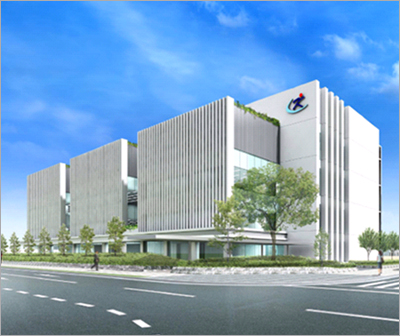- For Print
- July 30, 2012
Eisai Co., Ltd. (Headquarters: Tokyo, President & CEO: Haruo Naito, “Eisai”) announced today that its research and development subsidiary KAN Research Institute, Inc. (Headquarters: Hyogo Prefecture, President: Toshio Imai, “KRI”), currently located within the Kobe Biomedical Innovation Cluster, has received official approval from the city of Kobe to take part in a special international strategic development project being implemented within the Kansai International Strategic Innovation Zone and has therefore decided to relocate to a new research facility within the Zone in order to strengthen its research capabilities and increase the scale of its research. The new research facility has a total floor space of approximately 12,000m2, or roughly five times that of its current premises, with the capacity to house around 100 researchers, more than twice the present number. KRI plans to relocate to the new facility in 2014.
KRI is a research group that aims to discover and develop new drugs based on novel therapeutic concepts as one of the 12 units that comprise Eisai Product Creation Systems (EPCS). Specifically, the KRI is dedicated to conducting discovery research based on the concept of “Integrative Cell Biology for Medicine“ in its three areas of therapeutic focus-refractory immune diseases, neurodegenerative diseases and cancer relapse and metastasis.
Located within the Kobe Biomedical Innovation Cluster since October 2006, KRI has proactively undertaken product creation activities in partnership with other EPCS units and academia, resulting in it being able to bring E6011, a first-in-class antibody discovered in-house for the potential treatment of inflammatory bowel disease (IBD), successfully into clinical development in fiscal 2012. Going forward, KRI will continue to pursue greater levels of scrum-style open innovation by working in close collaboration with doctors and researchers at universities, hospitals and other institutions as part of the strategic project, in turn creating new medicines to treat neurodegenerative diseases.
KRI remains committed to uncovering disease mechanisms and generating novel therapeutic concepts based on human biology by concentrating its research efforts on the cell, the smallest unit of life-namely, the characteristics of specific cell types and molecule localization that cause disease. In order to turn the knowledge it has accumulated thus far and bring its enhanced pipeline to market as soon as possible, KRI will strengthen its research capabilities in the field of cellular biology, including cellular and molecular imaging, cell-specific differentiation markers and differentiation induction, and genetically-modified animals. KRI will leverage the benefits of its new facility being located within the Kobe Biomedical Innovation Cluster, one of Japan’s largest bioclusters, and work in collaboration with outside doctors and researchers to undertake innovative product creation activities as it seeks to ensure the delivery of new medicines that further help to increase patient benefits.
[ Please refer to the following notes for further information on the Kansai International Strategic Innovation Zone, the Kobe Biomedical Innovation Cluster and an artist’s impression of the new research facility ]
Media Inquiries:
Public Relations Department,
Eisai Co., Ltd.
+81-(0)3-3817-5120
< Notes to editors >
1. About the Kansai International Strategic Innovation Zone
The Japanese government, based on the country's New Growth Strategy (approved by the Japanese Cabinet on June 18, 2010), established the Comprehensive Special Zone System to implement a comprehensive policy package that encompasses deregulation policies as well as policies aimed at providing taxation, fiscal, and financial support. This system serves to provide comprehensive support tailored to the characteristics of each region for wide-raging and strategic region-based initiatives designated and accredited under the Comprehensive Special Zone Act of Japan through a range of deregulation, taxation, fiscal, and financial support policies. Relevant government ministries are involved in each of the projects included in the “Accredited Comprehensive Special Zone Plan,” and provide targeted financial support by leveraging the budgetary systems over which they have jurisdiction.
As members of the “Kansai International Strategic Innovation Zone,” Kyoto, Osaka and Hyogo prefectures are working in collaboration with the cities of Kyoto, Osaka and Kobe in an effort to create a structure that promotes the provision of solution-oriented businesses and market expansion initiatives capable of dealing with an aging society, energy problems and other issues that pose a challenge, not only to Japan, but also to countries across all of Asia, in healthcare/medicine and battery-derived energy applications-two areas in which the Kansai area excels.
2. About the Kobe Biomedical Innovation Cluster
The City of Kobe has been working in cooperation with the public, private and academic sectors to establish a research and development hub on Port Island for the advancement of medical technology. The “Kobe Biomedical Innovation Cluster” is designed to provide employment opportunities, revitalize the area's economy and to make an international contribution to other Asian nations. The main areas of research being pursued within the cluster include medical device-related research and development, clinical application of regenerative medicine, and clinical research support (clinical trials) for pharmaceutical products. Having attracted more than 200 medical-related companies in the 14 years since its establishment, the “Kobe Biomedical Innovation Cluster” was one of nine areas within the Kansai region to be designated by the Japanese government as part of the “Kansai International Strategic Innovation Zone.” Going forward, the city of Kobe will further accelerate its “Biomedical Innovation Cluster” initiative as it seeks to create Asia's No.1 biomedical cluster to drive the entire Japanese economy.
3. Artist's Impression of the New Research Facility

